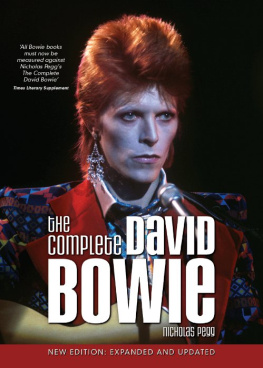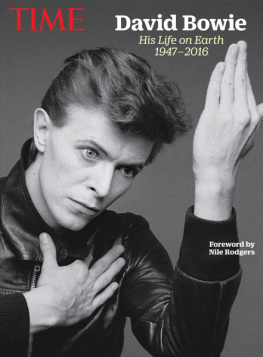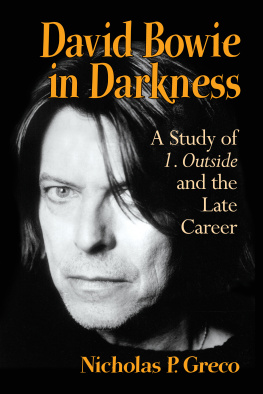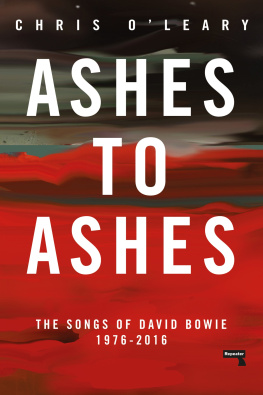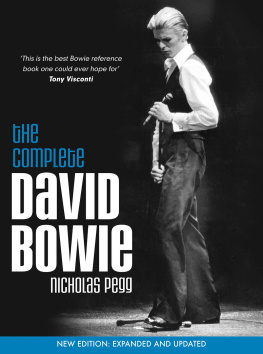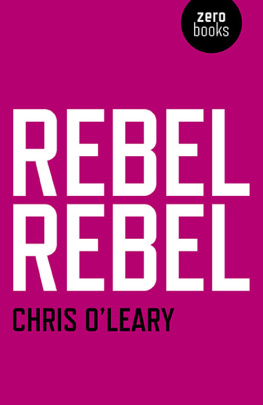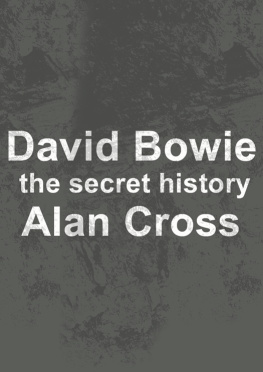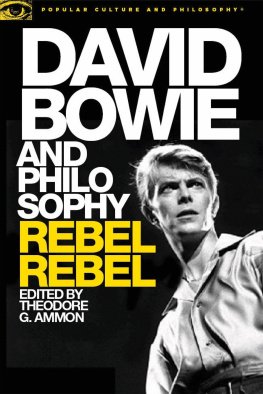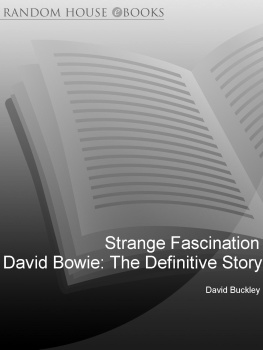
THE COMPLETE
DAVID BOWIE
EXPANDED and updated SIXTH EDITION
NICHOLAS PEGG
TITAN BOOKS
Front cover: Performing My Death on Russell Harty Plus Pop, 17 January 1973 (photograph ITV / Rex Features)
Back cover (top): Performing Cracked Actor at the Vorst Nationaal, Brussels, 19 May 1983 (photograph Ilpo Musto / Rex Features)
Back cover (bottom): Performing New Killer Star at the Isle of Wight Festival, 13 June 2004 (photograph Brian Rasic / Rex Features)
THE COMPLETE DAVID BOWIE
ISBN: 9780857682901
Published by
Titan Books
A division of Titan Publishing Group Ltd.
144 Southwark St.
London
SE1 0UP
First Titan edition: September 2011
10 9 8 7 6 5 4 3 2 1
The Complete David Bowie copyright Nicholas Pegg 2000, 2002, 2004, 2006, 2009, 2011.
All rights reserved.
The moral right of Nicholas Pegg to be identified as the Author of the Work has been asserted by him in accordance with the Copyright, Designs & Patents Act 1988.
Did you enjoy this book? We love to hear from our readers. Please e-mail us at: or write to Reader Feedback at the above address.
Designed by Amazing 15, based on original design by Chris Bentley.
To receive advance information, news, competitions, and exclusive offers online, please sign up for the Titan newsletter on our website: www.titanbooks.com
No part of this publication may be reproduced, stored in a retrieval system, or transmitted, in any form or by any means without the prior written permission of the publisher, nor be otherwise circulated in any form of binding or cover other than that in which it is published and without a similar condition being imposed on the subsequent purchaser.
A CIP catalogue record for this title is available from the British Library.
Printed and bound in the USA.
INTRODUCTION: THE MUSIC IS OUTSIDE
The piece of work is not finished until the audience come to it and add their own interpretation and what the piece of art is about is the grey space in the middle.
David Bowie, December 1999
On 8 January 1947 Elvis Presley celebrated his twelfth birthday and Stephen Hawking his fifth. In New York, Jackson Pollock made his first drip-painting. In London the day began with a portent, when freezing conditions caused the Lambeth Town Hall clock to strike thirteen times at midnight. Less than half a mile away, at 40 Stansfield Road, Brixton, Peggy Burns gave birth to a baby boy.
This book is about that boy, but it is not a biography. Its a reference work which, it is to be hoped, will satisfy the enthusiast and inform the newcomer. To both I implore: if you want to enjoy David Bowies work to the full, keep an open mind. What makes Bowie such a supremely fascinating artist is that his career presents an implicit challenge to conventional notions of creative continuity. He has repeatedly confounded attempts to pigeon-hole him as this or that kind of artist, and the result has been one of rock musics longest and most successful careers. People would like artists to be expendable, to fit into one generation or another, said Bowies painter friend Julian Schnabel in 1997. They dont like it when somebody keeps going. Bowie himself is fond of quoting a maxim of Brian Enos, as he did on Radio 2s Golden Years documentary in March 2000: In art you can crash your plane and walk away from it. If you have that chance, you should take it. The worst thing would be to maintain a particular kind of celebrity and commercial success for the entire career, and then look back and think of all the things that one could have tried and could have done, and think why didnt I do that?
There will always be those who mistrust Bowie because he borrows other peoples ideas. Serious glam-rockers will state a preference for Marc Bolan, advocates of synthesizer minimalism will go straight to Kraftwerk, soul-boys grimace at Young Americans, drumnbass aficionados have no time for Earthling. Bowies ability to remake his music, his appearance and even his personality has prompted some to accuse his work of a kind of fundamental dishonesty. The charge frequently levelled against Bowie throughout his career is that he is a dilettante, a style vampire who has his finger on the pulse but never his hand on his heart. Some people say Bowie is all surface style and second-hand ideas, said Brian Eno in 1999, but that sounds like a definition of pop to me. Its a folk art. Its only in the conceited fine arts that were supposed to be totally original and pretend that it came out of nowhere, straight from God to us. In pop music, everyone is listening to everyone else. A decade earlier Bowie had told Melody Maker that Theres no point in just ripping something off, but if you hear something and think, I like what that guy is doing; I know what I can do with that, its like having a new colour to paint with, and I think it depends very much on what you do with that colour once youve found it.
The not uncommon hypothesis that the Ziggy Stardust period is Bowies only true moment of relevance is based on the circumstantial fact that thats when the public at large happened to start buying him. I know that they were decisive years for me, David said in 1998, because for the first time I had a real audience. But at the same time, I really worked hard before 1970. Glam rock was merely the latest idiom of an artist who had already worked though the guises of R&B frontman, Mod, psychedelic balladeer, Dylanesque protest singer and embryonic prog-rocker. Bowie has attributed the long years of his pre-fame struggle to the very fact that he was unwilling to nail his colours to one stylistic mast: At that point, particularly, it wasnt right to have an interest in all areas, he said in 1999. It was make-your-mind-up time. You were either a folk singer or a rock singer or a blues guitarist ... I felt: well, I dont wanna be like this. I wanna keep my options open; theres lots of things I like. In 2003 he described his creative principle as an undiminished idea of variability. I dont think theres one truth, one absolute. Its an idea that I have always felt instinctively, but it was reinforced by the first thing I read on postmodernism, a book by George Steiner called In Bluebeards Castle. That book just confirmed for me that there was actually some kind of theory behind what I was doing with my work realizing that I could like artists as disparate as Anthony Newley and Little Richard, and that it was not wrong to like both at the same time. Or that I can like Igor Stravinsky and The Incredible String Band, or The Velvet Underground and Gustav Mahler. That all just made sense to me. Commercially Ziggy Stardust was of massive significance, but artistically it was just another milestone on the meandering road of discovery. Bowie may not have invented glam, but the point is that he conquered it. Unlike Bolan, he then escaped it. A few years later he repeated the same pattern with synthesizer pop, dropping a few classic albums our way and leaving behind another trail of imitators who failed to move on. Thats what makes him David Bowie.
And thats why, despite the occasional commercial jackpot, Bowies music has never been wholly accepted in America, where honesty and denim and Bruce Springsteen are what rock music is all about: Im not a guy that gets on stage and tells you how my days just gone, he once remarked. Bowies work is about artifice, about allusion, about signifying the enactment of rock music. I feel like an actor when Im on stage, rather than a rock artist, he told
Next page
